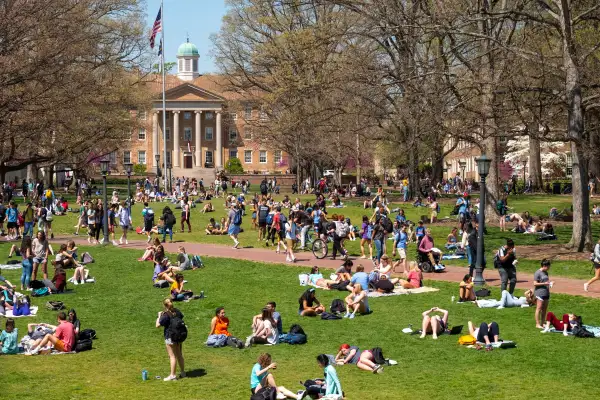These Public Universities Scored Highest on Money's 2025 Best Colleges List

More than 60% of students working toward a bachelor’s degree attend a public college. With today’s tuition prices, one of the main reasons why shouldn’t come as a surprise: Attending an in-state public college is often a student's most affordable option.
But that doesn’t make it cheap. The average annual tuition and fees for residents at a four-year public college was $11,610 last year, according to the College Board. Add in room and board, and the annual sticker price at public colleges topped $24,000.
As a result, families are increasingly focused on the likely return on investment for their tuition dollars. Money’s 2025-2026 Best Colleges list, released last week, can help you research public schools in your state from such a lens.
Money looked at 25 data points to produce this year’s list, with a particular emphasis on graduation rates, typical prices and borrowing amounts, and outcomes such as median alumni salaries and the share of recent grads with jobs. (Read a more in-depth methodology here.)
Overall, there are 270 public institutions that make the cut for the 11th edition of our Best Colleges franchise, including roughly 45% of the top quartile of the list.
Among the 19 schools that earn a 5-star, our highest rating, you’ll find well-known flagships like the University of Michigan and the University of North Carolina Chapel Hill, as well as schools that stand out for affordability and accessibility, such as the University of Illinois Chicago and several regional California State University campuses.
What are the 5-star public colleges?
Here’s a look at the top-scoring public colleges on our 2025-2026 list, in alphabetical order. See the full list of best public colleges.
California Polytechnic State University, San Luis Obispo
- Acceptance rate: 30%
- Est. price with average aid: $17,900
- Graduation rate: 86%
About 90% of Cal Poly graduates are working full time or in graduate schools within a year, the school reports. Students go on to earn median salaries of just over $90,000 in their early careers, a premium over similar schools, according to Money's analysis. Full profile.
California State Polytechnic University, Pomona
- Acceptance rate: 74%
- Est. price with average aid: $12,600
- Graduation rate: 86%
Cal Poly Pomona's learn-by-doing approach provides a wealth of internships and research positions, and it also yields some fun opportunities, such as learning craft beer-making at an on-campus brewery and building parade floats in a 14,000-square foot float lab and design complex. Full profile.
California State University, Dominguez Hills
- Acceptance rate: 91%
- Est. price with average aid: $4,700
- Graduation rate: 69%
Like much of the Cal State system, the Dominguez Hills campus is a catalyst for economic mobility, with one of the highest ratings on think tank Third Way's index measuring how well colleges help lower-income students advance. Full profile.
California State University, Fullerton
- Acceptance rate: 87%
- Est. price with average aid: $6,700
- Graduation rate: 80%
Popular majors at this Orange County campus include business administration, psychology, kinesiology, communications and art. Full profile.
California State University, Long Beach
- Acceptance rate: 47%
- Est. price with average aid: $10,300
- Graduation rate: 83%
With more than 30,000 undergrads, CSULB, or “The Beach,” is one of the largest schools in California. As such, the university feels almost like a small city, boasting its own art museum, gardens, convenience stores and restaurants. Full profile.
California State University, Los Angeles
- Acceptance rate: 92%
- Est. price with average aid: $4,800
- Graduation rate: 64%
Nestled between downtown Los Angeles and the San Gabriel Mountains, California State University, Los Angeles attracts students who want to excel in the areas of business, nursing, engineering and aerospace. (The school is a regular recipient of NASA grants aimed at boosting student involvement in the agency’s research and interest in STEM-related careers.) Full profile.
California State University, San Bernardino
- Acceptance rate: 98%
- Est. price with average aid: $7,100
- Graduation rate: 69%
About 7 in 10 undergraduates at Cal State Bernardino are Hispanic, and the school is designated as a Hispanic-Serving Institution by the U.S. Department of Education. Money’s analysis finds the university’s graduation rate is about 20% higher than predicted for institutions that enroll similar student populations. Full profile.
California State University, Stanislaus
- Acceptance rate: 97%
- Est. price with average aid: $7,800
- Graduation rate: 69%
As one of many efforts to raise completion rates, Stan State partnered with the nonprofit College Possible four years ago to launch Catalyze. The program connects students with “near peer” coaches to help them navigate common barriers that get in the way of completing a degree. Full profile.
Georgia Institute of Technology
- Acceptance rate: 16%
- Est. price with average aid: $16,900
- Graduation rate: 92%
One of the top engineering schools in the country, Georgia Tech’s alumni regularly post impressive, six-figure salaries. Despite the university’s reputation as a STEM powerhouse, enrollment at its College of Liberal Arts is growing, and students can choose from a variety of engaging minors focused on Korean, science fiction studies and sustainable cities. Full profile.
San Jose State University
- Acceptance rate: 80%
- Est. price with average aid: $14,700
- Graduation rate: $14,700
Among the Cal State schools, this Bay-area campus scores particularly well in Money’s outcomes bucket. A decade after enrolling, the median alumni earnings are nearly $79,000, significantly higher than expected compared to schools with similar student demographics. Full profile.
University of California, Berkeley
- Acceptance rate: 12%
- Est. price with average aid: $18,000
- Graduation rate: 93%
Long considered an elite public college, Cal boasts one of the highest graduation rates in the country (among both private and public schools). Full profile.
University of California, Davis
- Acceptance rate: 42%
- Est. price with average aid: $18,400
- Graduation rate: 89%
Students can choose from about 100 majors at the University of California, Davis, which is known for its agriculture, forestry and veterinary medicine departments. Thanks to the UC system’s robust financial aid, families with incomes under $100,000 pay no tuition (53% of in-state students there qualify for that deal, UC Davis says). Full profile.
University of California, Irvine
- Acceptance rate: 26%
- Est. price with average aid: $15,500
- Graduation rate: 85%
UCI likes to tout its diversity: About 4 in 10 students are first-generation college students, and 35% of undergraduates qualify for need-based Pell Grants. Plus, the college has been designated both a Hispanic-Serving Institution and an Asian American and Native American Pacific Islander-Serving Institution, meaning it enrolls significant populations of each. Full profile.
University of California, Los Angeles
- Acceptance rate: 9%
- Est. price with average aid: $16,100
- Graduation rate: 93%
There's a lot of star power at UCLA. Professors include bestselling author and geographer Jared Diamond, whose bevy of awards include a Pulitzer Prize; mathematician Terrance Tao, who is sometimes called the “Mozart of Math”; and astrophysicist Andrea Ghez, who won the Nobel Prize in physics in 2020 for research on black holes. Full profile.
University of California, San Diego
- Acceptance rate: 25%
- Est. price with average aid: $14,100
- Graduation rate: 90%
A well-respected research institution, UC San Diego is known for its science programs and stellar faculty. As such, the list of most popular majors comes as little surprise: Anatomy, biology, molecular and cell biology, and cognitive science all make the cut. Full profile.
University of Illinois Chicago
- Acceptance rate: 79%
- Est. price with average aid: $12,200
- Graduation rate: 68%
The University of Illinois Chicago scores well on Money’s value-added measures. The graduation rate is about 17% higher than predicted based on campus demographics, and the median early career salary (about $69,000) is more than $15,000 higher than predicted. Full profile.
University of Illinois Urbana-Champaign
- Acceptance rate: 44%
- Est. price with average aid: $15,200
- Graduation rate: 85%
The University of Illinois system's flagship campus scores highly on Money's measures of affordability, with an estimated net price of a degree of roughly $113,000 (not including state and federal aid) for in-state students. Most students from low- and middle-income families pay less than $10,000 a year to attend. Full profile.
University of Michigan
- Acceptance rate: 18%
- Est. price with average aid: $20,200
- Graduation rate: 93%
The University of Michigan is remarkably well-rounded: The estimated net price of a degree for in-state students is comparably affordable — about $102,000 before state and federal aid. The university has one of the highest graduation rates of all the schools we evaluated, and the median early career earnings of alumni exceed those of 90% of colleges on our list. Full profile.
University of North Carolina at Chapel Hill
- Acceptance rate: 16%
- Est. price with average aid: $11,800
- Graduation rate: 91%
UNC at Chapel Hill, the nation's first public university, has long been known as one of the best bargains for a competitive school. Before factoring in federal or state financial aid, the net price of a degree is about $94,000 — less than some 680 colleges on our list. Full profile.
Notes: Acceptance rates reflect the rates reported in IPEDS for the 2023-2024 school year. Est. price with average aid is the average net price paid after grants from federal, state and institutional sources. Graduation rates are six-year completion rates for degree-seeking students and include transfer students.
More from Money:
These Are the Best Colleges in America Right Now



